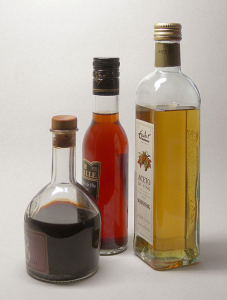One of our most popular posts on the Vintage Cellars Blog has been How to Make Your Own Red Wine Vinegar. Our readers seem to love the idea of using up bottles of red that are a little past their prime to make something delicious and useful. But did you know that it's just as easy to make your own white wine vinegar as it is to make red? Here's what to do:
1. Buy a ceramic or glass crock. At least a one gallon size is best--this seems excessive, but you'll want enough room to add lots of extra wine, and you don't want to be limited in how much vinegar you can produce--small bottles of your homemade vinegar make great gifts! Make sure your crock has a spigot to make bottling your vinegar easy.
2. Obtain a vinegar starter, commonly referred to as a mother. A mother is a combination of cellulose and acetic acid bacteria. It uses oxygen from the air to turn alcohol into acetic acid. A mother is a weird cloudy mass that sits at the bottom of your vinegar crock. Although it looks unappetizing, it won't hurt you, and you can easily strain it out of your vinegar with a coffee filter if you want to. You can get a vinegar mother from a beer and wine-making supply store, from the internet, or from a vinegar-making friend.
3. Put the vinegar in the crock, then add diluted white wine in the ratio of 2 parts wine to 1 part water. The less you add, the more quickly it will turn to vinegar. 2 cups wine to 1 cup water is a good start. The better the wine is, the better the vinegar will be, because good wines have a variety of complex flavors, which will translate to an interesting, full-flavored vinegar.
quickly it will turn to vinegar. 2 cups wine to 1 cup water is a good start. The better the wine is, the better the vinegar will be, because good wines have a variety of complex flavors, which will translate to an interesting, full-flavored vinegar.
4. The best thing about vinegar making is that you can use those half-empty bottles that have been taking up space in your fridge. Since the alcohol in wine starts to turn into acetic acid when you open it, wine a little past its prime simply has a jump-start on becoming vinegar! Because of this, vinegar-making is very cost-effective.
5. Cover the top of your crock with a cheesecloth and attach it firmly with a rubber band. This keeps out insects, but lets in the oxygen that makes the process happen.
6. Add small doses of white wine once a week or so. (Or whenever you have a half-empty bottle sitting around.)
7. Wait at least 12 weeks, then taste-test. If it smells like vinegar and tastes like vinegar, it's ready! Bottle it using a funnel. Any vinegar left in the crock (be careful to leave the mother, too), you can continue to use to make more vinegar. Just keep adding more white wine! Use your vinegar to make sauces and vinaigrettes, and a million other tasty dishes.
You'll find that homemade vinegar has a much different taste than store-bought--it's fuller and richer, and doesn't have as much harsh bite to it. You can use it in endless ways in the kitchen, and it makes great gifts. Check our next post for a description of how to take your homemade vinegar by making pretty and delicious flavored vinegars.


